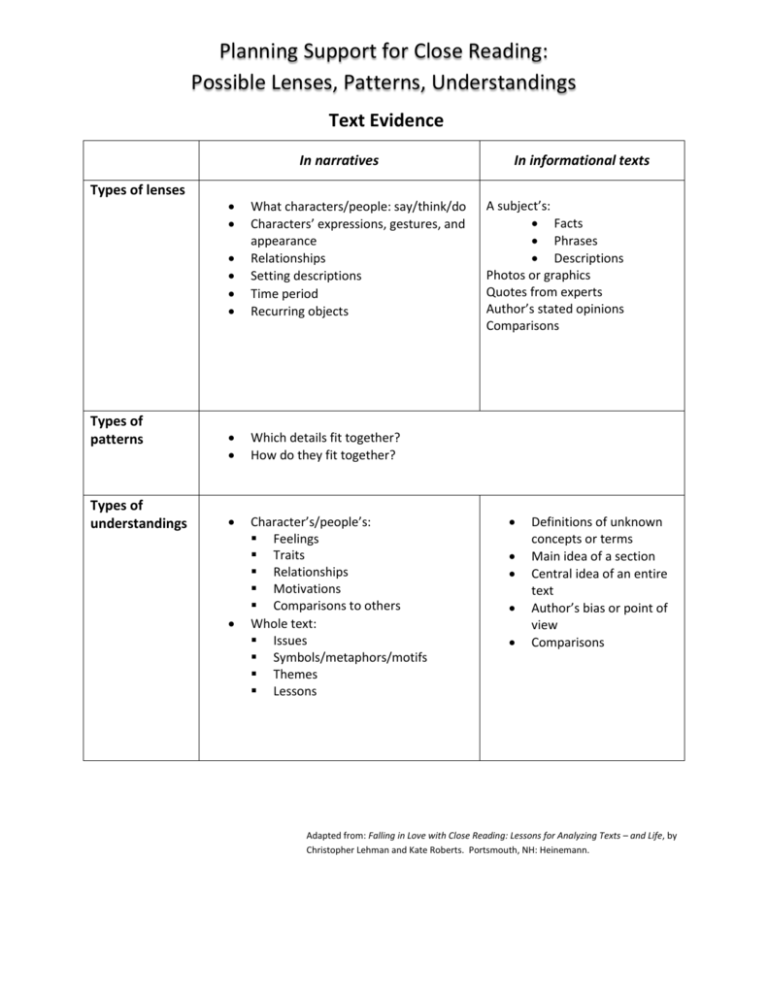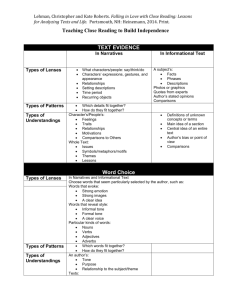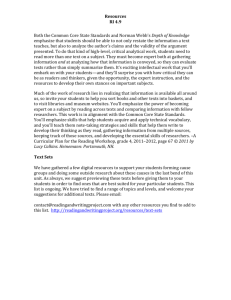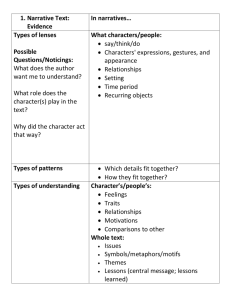Text Evidence
advertisement

Planning Support for Close Reading: Possible Lenses, Patterns, Understandings Text Evidence In narratives Types of lenses Types of patterns Types of understandings What characters/people: say/think/do Characters’ expressions, gestures, and appearance Relationships Setting descriptions Time period Recurring objects Which details fit together? How do they fit together? Character’s/people’s: Feelings Traits Relationships Motivations Comparisons to others Whole text: Issues Symbols/metaphors/motifs Themes Lessons In informational texts A subject’s: Facts Phrases Descriptions Photos or graphics Quotes from experts Author’s stated opinions Comparisons Definitions of unknown concepts or terms Main idea of a section Central idea of an entire text Author’s bias or point of view Comparisons Adapted from: Falling in Love with Close Reading: Lessons for Analyzing Texts – and Life, by Christopher Lehman and Kate Roberts. Portsmouth, NH: Heinemann. Planning Support for Close Reading: Possible Lenses, Patterns, Understandings Word Choice In narratives and informational texts Types of lenses Choose words that seem particularly selected by the author, such as: Words that evoke: Strong emotions Strong images A clear idea Words that reveal style: Informal tone Formal tone A clear voice Particular kinds of words: Nouns Verbs Adjectives Adverbs Types of patterns Types of understandings Which words fit together? How do they fit together? An author’s: Tone Purpose Relationship to the subject/theme Text’s: Central ideas Issues Lessons Symbols/metaphors/motifs Themes Adapted from: Falling in Love with Close Reading: Lessons for Analyzing Texts – and Life, by Christopher Lehman and Kate Roberts. Portsmouth, NH: Heinemann. Planning Support for Close Reading: Possible Lenses, Patterns, Understandings Structure In narratives Types of lenses In informational texts Lens #1: Describe the organization of the text: Lens #1: Describe the organization of the text: Genre as structure chosen for a purpose: Fantasy, to explore good and evil Historical fiction, to reflect on current ideas in a historical context Genre as structure chosen for a purpose: Editorial, to convince or persuade Article, to inform and educate Location of parts within the whole: Plot mountain: Exposition: introducing character, setting, and backstory Rising Action: pressures and obstacles Climax: dramatic point, characters or problems come together Falling Action: characters or communities change, lessons learned Resolution: ending, some things wrap up, others might not Technique the author uses: Descriptions Dialogue between characters Action Setting Inner thinking Scene endings and beginning Flashbacks Definition of a term Comparisons Location of parts within the whole: Sections Text features Order of techniques (see below) Techniques the author uses: Definition of a term Comparisons Cause or effect Description Anecdote Claim Lens#2: Purpose of that organization: To present a cause for an effect To make a complex idea more concrete To provide context To clear up misconceptions To develop a reader’s expertise Lens #2: Purpose of that organization: To set the stage To reveal To create suspense To foreshadow Types of patterns Types of understandings How are the parts similar? How are the parts different? What purpose do the parts serve? Character: Development Changes Critical moments Whole Text: Themes Central Ideas Issues Lessons Symbols/metaphors/motifs Author’s purpose Definitions Main idea of a section Central idea of an entire text Author’s bias or point of view Purpose behind the author’s choices Adapted from: Falling in Love with Close Reading: Lessons for Analyzing Texts – and Life, by Christopher Lehman and Kate Roberts. Portsmouth, NH: Heinemann. Planning Support for Close Reading: Possible Lenses, Patterns, Understandings Point of View and Argument In narratives Types of lenses Lens #1: What is the author’s and/or character’s point of view here? What they are thinking What they believe What they feel or want Lens #2: What makes the author and/or character’s point of view persuasive? Text evidence Word choice Structure What characters: say/think/do Character expressions, gestures, and appearance Relationships Setting descriptions Time period Recurring objects In informational texts Lens #1: What is the point of view/argument? Lens#2: What makes the point of view/argument persuasive? Types of patterns Types of understandings Text evidence Word choice Structure Emotional appeals (personal stories or anecdotes) Engaging voice (humor, passion, or outrage) Sense of audience (angled evidence, or tone) Nods to commonly held beliefs or even stereotypes Cacophony, or “ranting” Rhetorical devices (metaphors, alliteration, or irony) Which points of view/ideas are repeated? What technique does the author use to make his or her point of view/argument? What sticks out as different or unusual in the text? What is the purpose or effect of these points of view? Ideas or claims Reasons the claim is right Evidence supporting the reasons Counterargument Logic Validity Relevance What is revealed about a theme? The author’s purpose? The effect on the reader? Which point of view is rewarded in the text? Comparison of points of view Validity and strength of the argument: Central idea or claim Most/least persuasive parts How similar or different from the reader’s point of view How well-supported Effective or ineffective parts The strength of counterargument Author’s style: Most commonly used craft or persuasion techniques Balance of style and argument Effective or ineffective persuasive techniques Adapted from: Falling in Love with Close Reading: Lessons for Analyzing Texts – and Life, by Christopher Lehman and Kate Roberts. Portsmouth, NH: Heinemann. Planning Support for Close Reading: Possible Lenses, Patterns, Understandings Reading Across Texts Types of lenses Lens #1: Choose a comparison: Characters or subjects Themes or central ideas Settings Authors (texts by the same author or different author) Genres Styles Other ways (awards won, time period, social issues, etc.) Lens #2: Then choose your texts: What other text fits with this chosen comparison? *Some students may find it helpful to flip these steps. Types of patterns Decide how to compare: Text evidence Word choice Structure Point of view Types of understandings Have new ideas about: The lens you looked through The authors’ choices The messages these texts send See characters or subjects as more complex Analyze kinds of relationships between characters or ideas in texts Theme or central idea When considering author’s purpose: Analyze each author’s point of view Understand more of an author’s style See how genre choices affect story, topic, or readers Examine what it takes to be an “award-winning” book Analyze what texts from a time period show us about that period in history Adapted from: Falling in Love with Close Reading: Lessons for Analyzing Texts – and Life, by Christopher Lehman and Kate Roberts. Portsmouth, NH: Heinemann.









